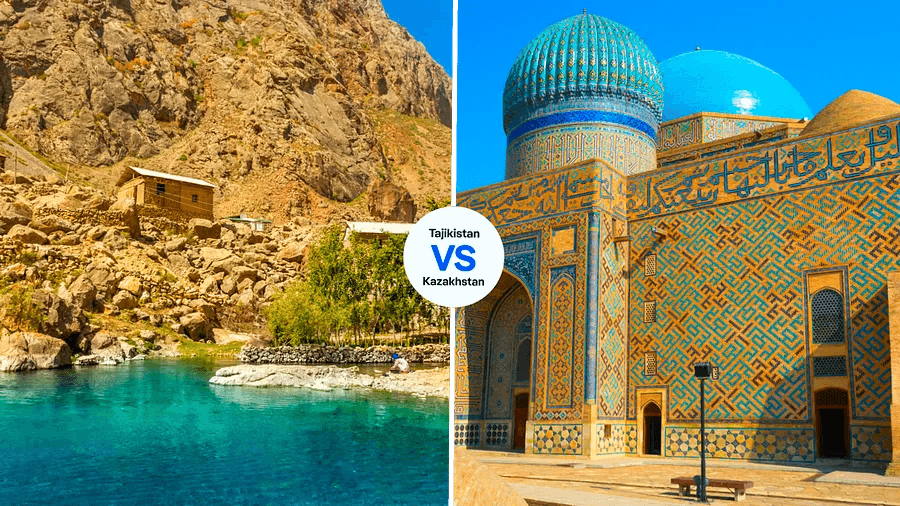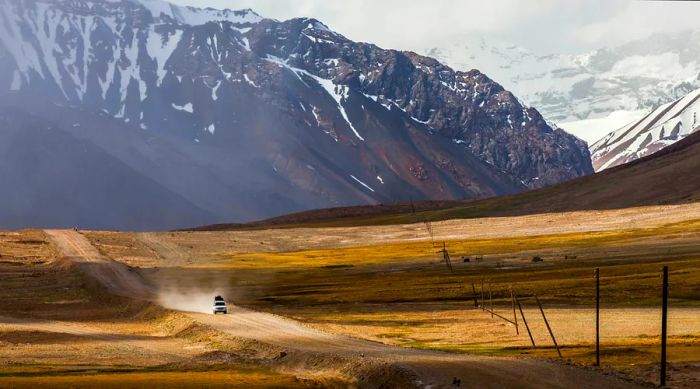Kazakhstan or Tajikistan? What should be your next destination after Uzbekistan?

If you, like many travelers, think of Central Asia as the home of the stunning Silk Road cities such as Khiva, Samarkand, and Bukhara, you’ll likely start your journey in Uzbekistan. With new visa policies and a welcoming atmosphere, it's an excellent choice, but the ‘stans’ have much more to offer beyond these iconic cities.
Which Central Asian country should you add to your Uzbekistan adventure to enhance your experience? The region’s charm lies in its remoteness. Will you venture north and northwest into the expansive landscapes of Kazakhstan, known for its vibrant capital, majestic canyons, and exceptional skiing? Or will you head southeast to Tajikistan, home to stunning mountains, picturesque lakes, and the renowned Pamir Highway, the second-highest international road in the world?
It’s a challenging choice – we consulted a pair of writers to guide you in making this tough decision.
 Embark on an adventure along Tajikistan's Pamir Highway. Lukasz Nowak/Shutterstock
Embark on an adventure along Tajikistan's Pamir Highway. Lukasz Nowak/ShutterstockExperience the thrill of adventure in Tajikistan
Mark Elliott is a travel writer who has been exploring Central Asia regularly since co-authoring the iconic 1990s guide, Asia Overland. He even found love with a fellow traveler he met at a camel market in Turkmenistan.
For me, Tajikistan embodies the essence of old-school adventure—journeys are challenging enough to make you appreciate the country’s stunning landscapes and slow you down, allowing you to fully savor those breathtaking moments that often catch you by surprise. There’s just the right amount of unpredictability to deter tourists who prefer a more structured experience (and who aren’t ready to keep an extra day or two free for possible roadblocks or changes in border regulations).
What makes Tajikistan a must-visit is its stunning mountains that greet you at every turn, along with views of Afghanistan that come without the risks of being there. You won’t face Kazakhstan’s expansive distances, and if you’re traveling from Uzbekistan, you can easily cross the border from Samarkand to Panjikent for a day—or even three—to explore the beautiful lakes and landscapes of the magnificent Fann Mountains.
Many adventurous travelers who spend an extended time in Tajikistan are drawn to the Pamir Highway, the second-highest international road in the world, located in the country’s far southeast. This exhilarating multi-day journey ascends through the culturally rich Pamir region, where you'll enjoy the warm hospitality of village homestays. Sleep in seemingly simple Pamiri box-houses, but be prepared for a surprise: inside, you'll discover stunning cedar beam-work and intricately designed wooden ceilings, all imbued with profound cosmological meaning.
The southern route of the Pamir Highway winds past ancient forts and presents numerous breathtaking viewpoints overlooking the river that borders Afghanistan’s Wakhan Corridor (always check safety advisories before visiting). As of summer 2024, the Saturday market in Ishkashim once again allows locals and visitors to engage with Afghan traders at the cross-border bazaar.
Further northeast, the Pamir Highway leads towards Kyrgyzstan, meandering up into a striking upland plateau that brings you to the culturally vibrant settlement of Murgab. While the town may lack architectural flair, it comes alive during the late-July At-Chabysh horse festival, a lively display of traditional sports and horsemanship that showcases local culture. Along the way, two stunning lakes await exploration: the mountain-encircled Kara Kul and the tranquil Bulunkul, surreal against its barren moonscape surroundings.
 The village of Jizeu serves as a serene oasis amidst the towering mountains of Tajikistan. Mark Elliott
The village of Jizeu serves as a serene oasis amidst the towering mountains of Tajikistan. Mark ElliottWhile the breathtaking vistas of Tajikistan are undeniably captivating, the true gem for me is the secluded, pristine lakeside village of Jizeu, which alone makes a trip to the region worthwhile. It’s one of those rare places that stirs a profound sense of wonder, reminiscent of the original Garden of Eden. Blink and look again through the green fronds of trees. Yes, those vibrant colors are indeed real—the brilliant blues, the reflections of soaring rocky cliffs, and the warm glow of sunset on the towering peaks. The modest little houses and gardens lining the lakeside add to the charm, as nearly every family provides homestays while genuinely maintaining their working farms.
Accessing Jizeu requires a trek on foot, with the trail starting on the 'wrong' side of the powerful river that rushes through the Bartang Valley. During my first visit, the experience was heightened by the unique crossing method: a swaying metal basket pulled across on pulley wires. Nowadays, a rickety footbridge has taken its place, yet it still sets an atmospheric tone for the two-hour hike ahead.
Then there’s the rapidly evolving capital, Dushanbe, home to some unexpected record holders: the world’s largest tea house and the former tallest flagpole (now fourth). Here, don't miss another hiking opportunity: a one- to two-hour trek up the Darshai Gorge. The allure lies not just in the endpoint but in the exhilarating stretches of path that cling to nearly vertical cliff walls. This trail, constructed from an eclectic mix of sticks, stones, and the occasional wire, offers a thrilling micro-adrenaline rush, adding to the collection of quirky experiences that make Tajikistan an unforgettable destination for adventurers.
 Take in the stunning turquoise domes of Turkestan. Shutterstock
Take in the stunning turquoise domes of Turkestan. ShutterstockImmerse yourself in the rich culture of Kazakhstan
Laura Seidanova, a travel writer with deep roots in Kazakhstan, is a true nomad at heart. Her passion for her homeland has led her to explore its remote corners, gathering stories she hopes to pass down to her grandchildren one day.
A Kazakh saying goes, 'Before inquiring about business, first offer your guest tea.' Indeed, in Kazakhstan, tea is a cherished ritual—we consume it abundantly. Even during the sweltering summer days, it serves as a moment of reflection, a pause to appreciate the simple joys of life.
While visitors may flock to Tajikistan for its hiking trails, Kazakhstan boasts stunning landscapes of soaring mountains, expansive steppes where wild horses graze, tranquil large lakes, and verdant pine forests. These natural treasures coexist with a rich cultural history, creating a striking juxtaposition between modern urban life and untamed nature. Our nomadic heritage has perfected the art of wandering while showing deep respect for the environment.
Before embarking on a journey, Kazakhs set positive intentions, wishing for a smooth voyage and warm interactions. For us, travel transcends mere exploration—it’s an opportunity for personal development. Whether you’re connecting with nature, discovering lively cities, or undertaking a spiritual journey, seeking experiences that foster resilience, broaden perspectives, enhance empathy, and build confidence is essential.
The cultural splendor and historical richness of Kazakhstan are sure to enchant any traveler. When I visited the Kazakh city of Turkestan, it felt as if I had traveled back in time, surrounded by ancient history. Turkestan, glowing in golden sunlight, showcases a stunning mix of age-old sand-colored buildings and shimmering turquoise domes against a deep blue sky. I wandered along clay-walled paths and explored vibrant bazaars, hunting for treasures like shapan (traditional robes), tumar (amulets), kumis cups, Kazakh jewelry, dombyra (traditional string instruments), and delectable chocolates from Rakhat. The awe-inspiring mausoleum of Khoja Ahmed Yasawi was a highlight, with peaceful camels resting nearby and playful gophers popping in – it was delightful!
Kazakhstan is also home to a wealth of natural wonders that draw ecotourists from around the world. As the ninth largest country globally, it offers a variety of eco-friendly travel routes, especially through its exceptional national parks, including Altyn-Emel, Ile-Alatau, Katon-Karagay, Burabay, Karkaraly, and Aksu-Zhabagly.
 Visit Aksu-Zhabagly National Park to witness its rare tulips. Shutterstock / Anyabr
Visit Aksu-Zhabagly National Park to witness its rare tulips. Shutterstock / AnyabrAksu-Zhabagly, one of the oldest national parks in Kazakhstan, is an extraordinary destination teeming with rare plants like Greig and Kaufman’s tulips. This region in southern Kazakhstan transforms into a stunning red floral tapestry during March and April, and witnessing this vibrant display is truly unforgettable. Just be aware that these tulips are highly protected—damaging them could result in fines up to 11 million tenge! So, enjoy the beauty while being mindful to protect it and keep your wallet safe.
Kazakhstan is not solely defined by its rich history and stunning landscapes; it also features several captivating modern cities, each with its unique atmosphere. Astana (now Nur-Sultan) impresses with a futuristic skyline highlighted by the Baiterek Tower and Khan Shatyr, resembling a scene from a sci-fi film. Almaty, nestled against the breathtaking Trans-Ili Alatau mountains, serves as a creative hub for artists. Here, you can enjoy espresso in stylish cafes, browse art galleries, or hike the nearby peaks. Then there's Shymkent, one of the country’s oldest cities, where the blend of ancient and contemporary creates a distinctive charm. Don't forget to grab a kurt (a savory dried cheese snack) while exploring the bustling bazaars.
Although the landscapes, architecture, and history are remarkable, it’s the people who truly shine in Kazakhstan. In Kazakh culture, guests are held in high regard. The practice of 'yerulik' invites visitors into homes, while the tradition of 'dam ayuz tiu' ensures no guest leaves hungry. Consequently, visitors enjoy generous meals often featuring beshbarmak, a traditional dish of boiled meat (lamb, beef, or horse) served atop flat noodles. Each meal and cup of tea feels like a warm embrace, inviting you to engage and experience the essence of Kazakh hospitality.
Growing up in Kazakhstan, I shared my street with children from Uzbek, Azerbaijani, Korean, Russian, and Uyghur backgrounds. I later learned that Kazakhstan is home to over 120 nationalities, each bringing their own culture and traditions. This rich diversity means that wherever I go, I always feel a sense of belonging.
Visiting Kazakhstan is an investment in unforgettable memories. It offers remarkable experiences and stories that you'll cherish and share with your grandchildren, especially those moments when you tried horse sausage and fermented camel milk – but that's a tale for another day.

1

2

3

4

5
Evaluation :
5/5